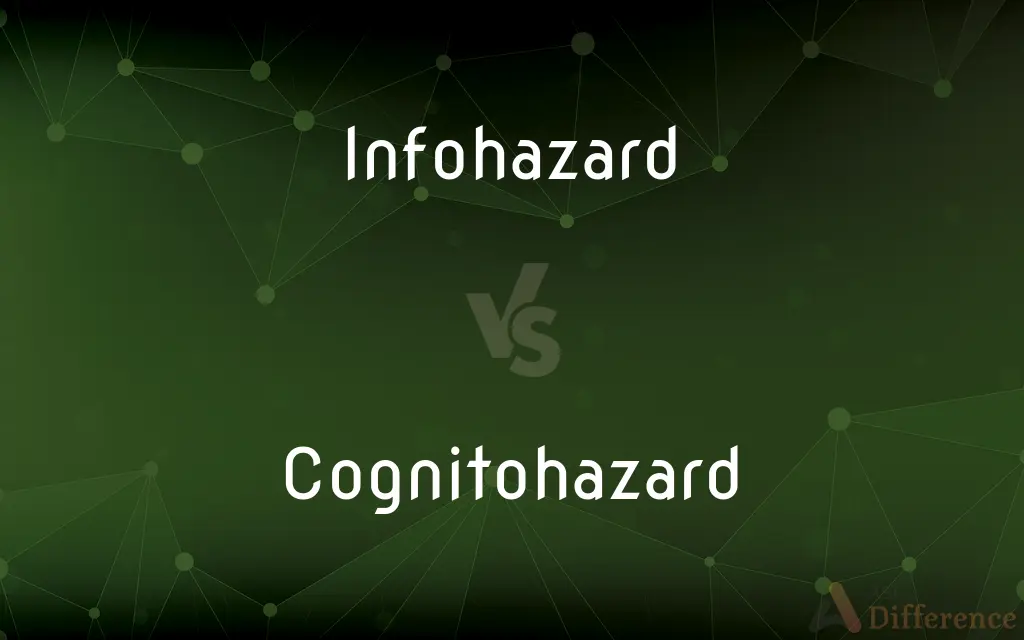Infohazard vs. Cognitohazard — What's the Difference?
By Tayyaba Rehman — Published on December 26, 2023
Infohazard pertains to knowledge or information that harms by being known. Cognitohazard causes harm through direct sensory perception.

Difference Between Infohazard and Cognitohazard
Table of Contents
ADVERTISEMENT
Key Differences
Conceptual Origins: The term Infohazard revolves around the idea that merely knowing or being aware of certain information can lead to harm. Cognitohazard, on the other hand, concerns stimuli that, when perceived through the senses, can cause harm to an individual.
Nature of Harm: With Infohazards, the danger comes from understanding or learning specific data or facts. With Cognitohazards, it's the act of direct perception, such as seeing or hearing, that brings about harm.
Protection Measures: To guard against Infohazards, one might avoid specific knowledge or maintain strict information control. For Cognitohazards, protective measures could include avoiding direct exposure, like wearing blindfolds or earplugs.
Examples: An Infohazard could be a piece of information that, when known, triggers self-destructive behavior. A Cognitohazard could be an image that, when viewed, induces severe pain in the observer.
Scope and Reach: Infohazards can be dangerous because their mere spread as knowledge can lead to widespread harm. Cognitohazards, however, require direct sensory exposure, limiting their potential harm to those who directly encounter the hazardous stimulus.
ADVERTISEMENT
Comparison Chart
Definition
Harm from knowledge or information.
Harm from direct sensory perception.
Trigger
Awareness or understanding.
Direct exposure like seeing or hearing.
Protection
Information control.
Avoiding direct sensory exposure.
Examples
Dangerous secrets or data.
Harmful images or sounds.
Potential Reach
Anyone aware of the information.
Those directly exposed to the hazardous stimulus.
Compare with Definitions
Infohazard
An Infohazard is harmful knowledge.
The discovery of the deadly formula was an Infohazard, endangering all who knew it.
Cognitohazard
Cognitohazards are dangerous stimuli.
The eerie melody was a Cognitohazard, sending listeners into deep trances.
Infohazard
An Infohazard damages by being disseminated.
The leaked code became an Infohazard, with hackers exploiting it worldwide.
Cognitohazard
A Cognitohazard harms upon sensory encounter.
The cursed painting was a Cognitohazard, causing anguish to all viewers.
Infohazard
Infohazards are threats rooted in cognition.
The mystic scroll was deemed an Infohazard, driving readers to madness.
Cognitohazard
Direct perception of a Cognitohazard leads to harm.
The labyrinth's center hid a Cognitohazard, a pattern inducing paralysis.
Infohazard
An Infohazard, when known, induces harm.
The true purpose of the ancient artifact was an Infohazard, best kept hidden.
Cognitohazard
Cognitohazards affect through sensory channels.
The forbidden dance was a Cognitohazard, ensnaring the minds of its audience.
Infohazard
Infohazards pose risks through awareness.
The revelation of the spy's identity was an Infohazard, compromising the entire operation.
Cognitohazard
Exposure to a Cognitohazard brings detrimental effects.
The glowing gem was a Cognitohazard, blinding those who gazed upon it.
Infohazard
A piece of information which is directly harmful to one who knows it.
Cognitohazard
An image, pattern, sound, or any other kind of sensory signal that directly causes harmful or undesired physiological effects to one who senses or perceives it.
The symbol on that piece of paper is a cognitohazard which puts everyone who reads it in a week-long coma.
Infohazard
An information hazard; a piece of information which can be used to cause harm by one who knows it.
Common Curiosities
Can you give an example of an Infohazard?
An example of an Infohazard could be a secret that endangers those aware of it.
Can the knowledge of a Cognitohazard be an Infohazard?
Potentially, if knowing about the existence or nature of a Cognitohazard causes harm.
Would a hypnotic image be a Cognitohazard?
Yes, if viewing the image causes harm or unwanted effects, it's a Cognitohazard.
Are Cognitohazards always visual?
No, Cognitohazards can be auditory, tactile, or any sensory stimuli that cause harm upon perception.
What's an Infohazard?
An Infohazard refers to harmful knowledge or information.
How does a Cognitohazard work?
A Cognitohazard causes harm through direct sensory perception, like seeing or hearing.
How can the spread of Infohazards be controlled?
Infohazards can be controlled by limiting the dissemination of the harmful information.
Are Infohazards fictional?
While the term is popular in speculative fiction, real-world parallels exist where certain knowledge can be harmful.
How does one recognize a Cognitohazard?
Recognizing a Cognitohazard can be challenging, as it's the direct sensory perception that causes harm.
Can an Infohazard be unintentional?
Yes, any piece of information, intentional or not, that harms by being known is an Infohazard.
How can one protect against Cognitohazards?
Protection against Cognitohazards might involve avoiding direct sensory exposure to the harmful stimulus.
Is a dangerous book an Infohazard?
Yes, if the content of the book, when known, causes harm, it's an Infohazard.
Is every harmful information an Infohazard?
Not necessarily. Only information that causes harm merely by being known qualifies as an Infohazard.
How widespread can the effects of a Cognitohazard be?
The effects of a Cognitohazard are limited to those directly exposed to the harmful stimulus.
Are all Cognitohazards harmful to everyone?
Not necessarily. Some individuals might be more susceptible to a Cognitohazard than others.
Share Your Discovery

Previous Comparison
Supernovae vs. Black Hole
Next Comparison
Arts vs. Fine ArtsAuthor Spotlight
Written by
Tayyaba RehmanTayyaba Rehman is a distinguished writer, currently serving as a primary contributor to askdifference.com. As a researcher in semantics and etymology, Tayyaba's passion for the complexity of languages and their distinctions has found a perfect home on the platform. Tayyaba delves into the intricacies of language, distinguishing between commonly confused words and phrases, thereby providing clarity for readers worldwide.
















































